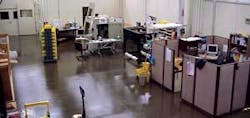Defining a laser system
Medical device makers are offered a guide to specifying a system
Steven D. Weiss
As the baby boom generation nears the beginning of its retirement phase, the needs for medical devices to extend the lives of an aging nation will grow. These devices, many of which are implantable, have features that require laser welding. Some of these examples include parts, such as batteries and capacitors that require laser welding at the sub-component level, and also at the final assembly level where a final hermetic seam weld is performed to produce pacemakers, Implantable Cardioverter Defibrillators (ICD), and drug pumps for the implantable market. The laser has become an acceptable tool to perform these welds on many different materials including aluminum, stainless steel, and titanium. As the need for implantable devices grows, the requirements of the laser workstation and its laser to work in close harmony have attained a new level of process control and tractability.
There are end users in the medical market and other industries who have been acquiring laser systems for years and who are familiar with the features needed to meet their specific needs. Laser integrators work closely with companies to help them define, as part of their specification, what they are looking for. The need to educate on some of this process from a laser integrator’s perspective will hopefully assist in the overall success of a future project.
Consider this; you are informed that an investment in laser technology as a tool for welding a new product is being put in motion at your company. This is the company’s first purchase of a laser system and you are tasked to head the project. If you have never had any experience with this type of capital equipment purchase your first thought may be where to start.
Scoping the project
First find out what your company’s needs are with regard to the system performance. With implantable medical devices, are value-added process control and tractability features needed to meet FDA requirements included in your budget? Based on what you currently know about this type of capital equipment, is there a realistic budget, what are future projected production rates, what shifts will be needed to achieve these numbers, and how many hours per day will you operate?
Also think about peripheral equipment like the chiller, fume handling, and electrical transformers. What are your deliverables? Document all milestones for the project and define the preliminary acceptance criteria as part of the specification.
The application
Work the application and become the process owner. As part of your evaluation, ask if the parts are being engineered with laser processing in mind. The success of this system really begins with the parts, how they are designed, and their joining application. One attribute to look for in your part design is gap; as a rule of thumb, any gap greater than 10 percent of the thinnest material is too large. Material will not flow well and the beam will get lost. So you will need to find the laser that is best suited for your application. Much of the information needed to quote a system starts with the laser application and establishes the laser as a viable process.
One method to achieve the laser application is to go right to the laser manufacturer, which usually has an applications lab setup. As you look at this phase of the project, be aware of time, money, and tooling. The laser manufacturer may already have applications in process. Many laser manufacturers do not charge for the basic laser applications, but there is a line where they may want to quote to process parts at a certain level. Applications lab personnel are a great resource but they do not have the time or resources to become tooling designers. In some cases they will need you to provide tooling to fixture the parts, so be prepared. Determine a schedule and how much product is needed to process your application, and if there is a cost associated. Ask what you can do to assist them in fixturing your product.
Integration sources
While discussing your application needs with the laser manufacturers don’t forget to discuss your laser workstation needs with them. Some manufacturers do not offer workstations but they will have referrals of integrators that can provide services to meet the level of complexity for your specification.
Some laser manufacturers do offer standard “off the shelf” systems to compliment the laser. Where the specification exceeds what they have to offer, they will refer to an integrator to pick up where their system leaves off. A few laser manufacturers offer systems with additional levels of complexity and engineering support to meet the customer’s specifications where required. A middle ground is the laser integrator who offers standard laser workstations and can handle laser integration into custom laser workstations based on the customer’s specifications. Some offer value added features on both standard and custom systems for process control and tractability for implantable medical devices. At the highest levels, most laser manufacturers tend to work with integrators who are better suited to handle large complex automated projects from a resource level.
Generally speaking, laser workstation configurations for single part flow can vary in size from the mini-desktop systems with work envelopes in the 4- to 6-inch3 travel range or less. Multi-part tooling is also possible when part feature size is not a constraint. Standard workstations that start in the 6- to 8-inch3 travel range and up to the 12- to 18-inch3 range are possibly the most popular platforms not only in the medical market. The upper end consists of standard and custom workstations that include palletized automation systems and gloveboxes for hermetic seal welding in an inert atmosphere.
The mechanical configurations of the systems are almost infinite, from aluminum extruded bases and bridges to structural steel weldments and granite. The motion system itself can be designed to have the X- and Y-axes stages together on the base with the Z-axis stage on the bridge, or in the same system platform, another configuration could locate the Y-axis on the base with the X-axis across the bridge with the Z-axis mounted to its tooling plate. Establish your tooling size and design early in the project if you are not reusing the tooling from the laser application.
If your need is accuracy and repeatability go directly to the linear motor stages in the horizontal planes. Stick with the ballscrew stage on the Z-axis, and don’t forget the brake on the Z-axis motor. A lot of this information is applicable to a fourth- and fifth-axis rotary stage application. You will need to specify the part and tooling weight, accuracy and repeatability, the maximum RPM, and include diameters of the stages that you feel are critical, if you need through holes in the center of the rotaries, and finally include the orientation to the X/Y plane.
A system structure is only as good as its foundation. Natural frequencies transmitted through the floor can affect the process. If you have concerns you will want to have it measured and consider installing additional anti-vibration material under the system, or you may need to install a system pad if the vibration is too excessive.
Personnel safety
Because we have already established that the application requires a Nd:YAG laser and it will be installed in a cleanroom, you’ll want to consider the overall safety of the personnel working around this system. It should be supplied as a CDRH Class I system with an enclosure, light tight and interlocked for eye safety. Other safety features include lightwave-safe viewing windows for the front doors.
Human interaction
Human Machine Interface (HMI) is the keystone of the entire system and controllers vary greatly from laser and system manufacturers. The Graphical User Interface (GUI) of the controller should be user friendly and intuitive with the primary screen revolving around the motion system. Programming the motion system is generally straight forward, as most use standard CNC style G & M code.
The expectations for quality in the medical market exceed that of many markets, thus laser welding system controllers for the implantable medical device market have advanced to new levels of functionality for process control and tractability and taking the operator out of the loop.
A vision system for process control can relieve the operator from finding part features and increase yields and throughput. Lighting is a critical aspect of the vision application for light intensity for process control functionality and color of the light.
Determining what information should be traceable is going to be difficult for the systems supplier to determine. They can provide as much information as possible. Basic information should include sampling the laser and shield gas delivery. All information should be stored locally or remotely. An additional example of data for tractability is system statistics.
System training
The most common maintenance training provided by the systems integrator should include the mechanical and electrical system of the workstation itself. The laser manufacturer will most likely provide this during the installation at your facility. Some laser manufacturers also provide additional advanced training at their facility at an additional charge.
Spending some additional funds as part of the project to have the systems integrator write your first part program can provide a template for use during training sessions. This will require tooling and parts to be sent to the systems integrator early so they will be prepared for preliminary acceptance. Make sure both you and the systems integrator are ready for your arrival.
Documentation and installation
The mechanical and electrical system documentation should include fully ballooned assembly and sub-assembly drawings with matching bill of materials. Consider having the system provided with electrical schematics in a pouch inside of the electrical box door itself. With that, the recommended spare parts list, and a preventive maintenance schedule, your maintenance personnel should be very pleased.
The systems integrator is required to provide to CDRH, as a report, an Accession Number, which provides information certifying the system meets CDRH requirements for a Class I system. You should receive a letter confirming the documentation through the systems integrator. Repeat standard systems use the same accession number as long as the system has not changed.
Check your maintenance personnel for installation requirements from their perspective. Always check local codes and OSHA standards for clearances to electrical boxes. Consider the location of the shield gas system. These can be provided from outside storage systems or bottled systems located locally to the system. Additional planning may be required if you need to have special foundations poured for anti-vibration needs.
After installation
Once the installation has been completed, the relationship between you and your system supplier changes to one of service and support. Find out when the warranty starts. Ask about response time to a service need. What is the availability of parts and who stocks them? Are there service programs available that can provide preventative maintenance? There may be methods of logging onto the system remotely so supplier support staff can be online to provide programming assistance, watch the program run, or take control of the system.
Conclusion
This article is not intended as an answer to all laser system questions, simply an example of the decisions to make when considering the purchase of a laser system as seen from a laser integrator’s perspective. Look inside your own company and understand its decision-making process. How does the process work, who will be signing off on this, and how long can you expect this process to take place? Include this in your schedule. What type of Return on Investment does your company use to justify capital equipment purchase? Is it a Standard Payback Method or Net Present Value? If this is an existing process, are there desired modifications? What are the current and future expected yields, system uptimes, and product throughput requirements? Who will be your company’s laser safety officer?
There are many organizations and seminars that can assist you to ensure you succeed. Above all do your homework and educate yourself. Become the process owner!
Steve Weiss ([email protected]) is with Innovative Laser Technologies Inc. (Fridley, MN; www.iltinc.com).




